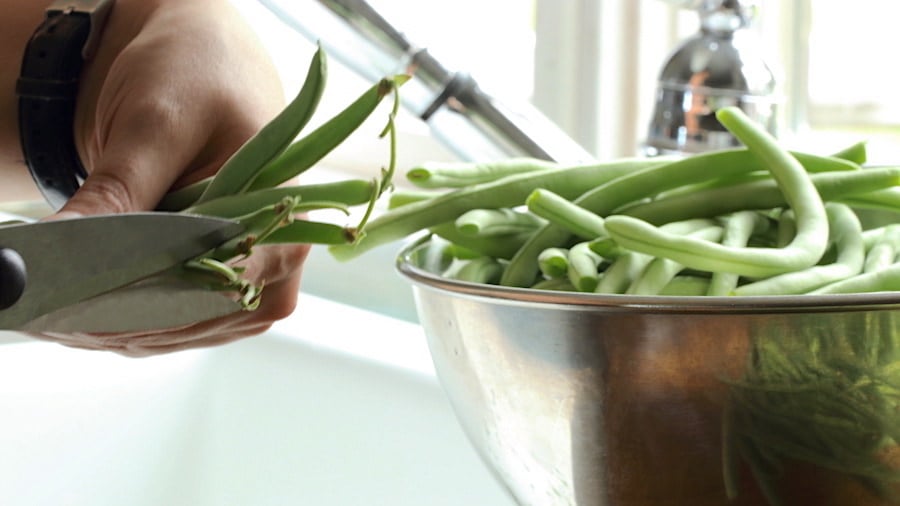This post explains how to freeze green beans without blanching them first. The process I use is very easy, especially if you have a vacuum sealer. If you don’t have a vacuum sealer, don’t worry! You can still use a straw to get the air out of the bags.
Jamie plants green beans twice a summer so that there are lots of fresh beans to eat during the season and extra to store for later. I can several jars of pickled beans with fresh dill each year. I also freeze several 1-pound packages to be enjoyed long after the gardens are put to rest.
This year’s first planting is a 20-foot row and it’s producing quite heavily right now. I picked about two pounds last week and over two and a half pounds this week. We used a lot of them to make my Dairy-Free Green Bean Casserole recipe (we love it so much we made it twice in two weeks), and we’ve also been adding them to other foods.
As you probably gathered from the title of this post, I don’t bother blanching the beans before freezing. You may be wondering why I skip this step. In reality, I’ve blanched beans before freezing them before, and I didn’t think that adding this extra step made the food taste better. As you may know, the National Center for Home Food Preservation (NCHFP) has a different view, which is shown in the text below.
Rest assured that I’m not the only one that chooses to skip the blanching process. If you search Google for “how to freeze green beans without blanching,” you’ll find a lot of posts written by people who agree with you. Since freezing food without blanching it doesn’t pose any health risks, I’m happy to go against what the NCHFP says in this case.
I would never cut corners when canning though. I always stick to recipes that have been tested in the lab and are okay to use. I would never risk getting my canned goods contaminated in any way.
Many home cooks blanch vegetables like green beans before freezing them. Blanching helps stop enzyme actions that can lead to loss of flavor, color, and texture. But is this extra step really necessary for freezing green beans and other beans? Let’s look at the pros and cons of freezing beans without blanching.
Why Blanch Vegetables Before Freezing?
The main reasons for blanching vegetables prior to freezing are
-
Stops enzyme actions that cause deterioration of texture, color, flavor and nutrients. Enzymes get deactivated by hot water.
-
Brightens color and helps retain color during freezer storage.
-
Softens vegetable fibers so texture is retained when thawed.
-
Removes any surface bacteria, dirt or insects.
-
Extends shelf life in the freezer.
Blanching typically involves plunging vegetables into boiling water or steam for 1-3 minutes depending on the vegetable. This deactivates enzymes but does not fully cook the veggies.
Is it Safe to Skip Blanching for Beans?
Many home cooks wonder – can you safely freeze green beans without blanching first? The answer is yes!
Green beans, snap beans, and other bean varieties maintain quality surprisingly well when frozen raw without any preliminary cooking.
When frozen quickly, the enzymes present naturally in beans do not have time to start deteriorating color, texture and flavor before getting deactivated by the cold freezer temperatures.
I tested freezing green beans both ways – with and without blanching – and found very little difference in the final results. Both batches of beans retained a bright green color and tender crunchy bite when cooked after freezing.
So blanching green beans before freezing is not essential for food safety or quality. It’s an optional extra step you can skip if short on time.
Tips for Freezing Beans Without Blanching
Follow these tips for best results when freezing beans without blanching:
-
Select young, tender beans. Older, more mature beans tend to become mushy when frozen raw.
-
Wash beans thoroughly to remove dirt and debris. Pat dry with towels.
-
Snap off ends and cut beans into uniform bite-size pieces if desired. Leave whole for fancy haricots verts.
-
Spread beans in a single layer on a sheet pan or baking sheet lined with parchment paper. Avoid stacking the beans.
-
Place pan in freezer. Once beans are completely frozen, transfer to airtight freezer bags or containers.
-
Squeeze out excess air and seal bags. Label with name and freeze date.
-
Use within 8-12 months for best quality.
Blanching May Still Have Benefits
Though not mandatory, blanching green beans and other beans still offers some advantages:
-
Blanching for just 1 minute further brightens green color. The colors of yellow beans, purple beans and other varieties also stabilize.
-
It yields more tender, pliable texture compared to frozen raw beans.
-
Blanching removes traces of grit or dirt that thorough washing may miss.
-
It allows beans to be frozen in bulk bags rather than spread on trays.
So blanching is still recommended for long freezer storage, especially with older, more mature beans. But for young tender beans consumed within a year, it’s fine to skip it.
How to Blanch Beans Before Freezing
If you do opt to blanch your beans before freezing, here’s a simple process:
-
Wash and trim beans as directed above. Leave whole or cut into pieces.
-
Bring a large pot of water to a boil. Use at least 4 quarts water per 1 pound of beans.
-
Add 1 tablespoon lemon juice or white vinegar to the boiling water. This helps maintain bright green color.
-
Add beans and blanch for 1 minute only to deactivate enzymes and brighten color. Avoid overcooking.
-
Immediately drain beans and submerge in ice cold water to stop cooking.
-
Drain beans well, pat dry and pack into freezer bags or containers. Exclude excess air.
-
Freeze right away for best quality retention.
How to Use Frozen Beans
Frozen green beans and other beans can be used in any recipe calling for fresh beans. Their texture becomes softer when thawed, so they work especially well in casseroles, soups, stir fries etc.
-
For green bean salads or side dishes, thaw first or use frozen beans briefly in hot skillet to heat through and restore some crispness.
-
Add frozen beans directly to simmering soups, stews or casseroles. Their texture softens perfectly during slow simmering.
-
For quicker cooking like stir fries, thaw partially first or increase stir frying time to allow beans to cook through.
Frozen beans that were blanched tend to have slightly firmer texture than those frozen raw. But both yield tender, tasty results.
Freezing green beans and other bean varieties without blanching first is completely safe. The frozen raw beans retain flavor, color and reasonable texture when thawed and cooked later. However, blanching for 1 minute before freezing better preserves the pliable, crunchy texture of fresh beans. It also brightens color and allows beans to be frozen in bulk. So blanching is still advised for extended freezer storage, though not absolutely necessary. With proper handling, beans frozen with or without blanching stay fresh and delicious for use in future meals.

What about the strings on string beans?
We never grow string beans. Who does that these days? There are many kinds of green beans that don’t have tough strings that you have to pull out. Should you have string beans, cut off the blossom end and pull off the string all at once. Then, cut off the other end.
- I prefer to snip the ends off over the sink
- The beans dry in just 20 minutes.
Once the beans are ready, rinse them well and drain in a colander. Next lay them out on towels to dry. You don’t want to freeze wet beans because they’ll develop unwanted ice crystals.
It helps to use a kitchen scale to measure the beans and know how much to put in each package. If you don’t have a scale, just eyeball it.

- Two pounds of beans weighed and portioned
- Vaccum-sealed in flat packages, marked, and ready to go in the freezer
Only freeze fresh and tender beans
For best results always start with fresh and tender beans. Trust me, freezing old and overgrown beans won’t improve their quality – it will only make them tougher. The best case scenario is to pick tender young beans, and freeze the same day.

Freezing Beans Without Blanching (Super simple for beginners!)
FAQ
What happens if you freeze beans without blanching?
Can you freeze uncooked beans?
Why are my green beans soggy after freezing?
Can I freeze runner beans without blanching?
Can green beans be frozen without blanching?
Once the green beans are washed and cut, it’s time to move on to the freezing process. To freeze fresh green beans without blanching, start by spreading the prepared beans out on a baking sheet in a single layer. Place the baking sheet in the freezer and allow the green beans to freeze for 1-2 hours, or until they are firm to the touch.
Can you freeze green beans?
Wash green beans if needed and dry completely. (See Notes below) Trim green beans ends and cut into 1 to 1-inch lengths (or desired size). Place in quart-sized zip-top freezer bags, removing as much air as possible with a straw (or other method) and seal. Label with date and what’s in the bag, place in freezer and freeze for up to a year.
Do you wash beans before freezing?
I do recommend washing your beans before freezing. Even if you garden organically, contaminants drift in on the wind. After washing or blanching, make sure to dry your beans well. Excess water means more ice crystals in your beans. I spread my beans on a kitchen towel and pat dry, or use the salad spinner.
Can you freeze blanched beans?
As an experiment, I vacuum sealed and froze both blanched and unblanched beans. The blanched beans had a much nicer texture, even after longer storage (over a year). By two years, the unblanched beans were bitter and very chewy. The blanched beans had very little change in storage and were still tasty.
